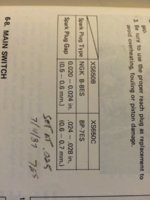Things to do when you have incurable insomnia.
Count sheep.
Or
Research something like the strange E3 part numbering system.
E3 sparkplugs that will screw into Yamaha XS650heads
Thread Diameter = 14mm
Thread Pitch = 1.25mm
Thread Length = 19mm (3/4")
Resistor types only
It appears that the number of legs supporting their "Diamond Fire" ground electrode defines the intended severity of application. Single leg for lawnmowers, two legs for motorcycles, three legs for cars. The center electrode can be fully rebated, like the old B8ES plugs, partially projected, or fully projected. The E3 recommended plug is a mid-projected tip. The longer projected versions may not work in our XS650 engines, due to physical contact with the pistons, or from piston blocking of the "Diamond Fire" blast nozzle.
Single ground leg (Lawn & Garden)
E3.18 - (13/16") socket, HOT (Champion 3-7, NGK 5-7) (mid-projected tip)
E3.20 - (5/8") socket, HOT (Champion 12-14, NGK 4-6) (full-projected tip)
E3.22 - (13/16") socket, HOT (Champion 9-12, NGK 5-7) (full-projected tip)
Dual ground legs (Motorsports, Motorcycle)
E3.31 - (13/16") socket, COLD (Champion 4-7, NGK 7-10) (non-projected tip)
E3.34 - (13/16") socket, HOT (Champion 9-16, NGK 2-7) (mid-projected tip) [Recommended by E3]
Triple ground legs (Automotive)
E3.46 - (13/16") socket, HOT (Champion 9-16, NGK 4-6) (full-projected tip)
E3.48 - (5/8") socket, HOT (Champion 12-14, NGK 4-6) (full-projected tip)
E3.64 - (5/8") socket, MID (Champion 8-10, NGK 6-7) (full-projected tip)
Full E3 website descriptions:
http://e3sparkplugs.com/parts/?part=E3.18&cr=1
http://e3sparkplugs.com/parts/?part=E3.20&cr=1
http://e3sparkplugs.com/parts/?part=E3.22&cr=1
http://e3sparkplugs.com/parts/?part=E3.31&cr=1
http://e3sparkplugs.com/parts/?part=E3.34&cr=1
http://e3sparkplugs.com/parts/?part=E3.46&cr=1
http://e3sparkplugs.com/parts/?part=E3.48&cr=1
http://e3sparkplugs.com/parts/?part=E3.64&cr=1



